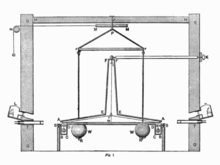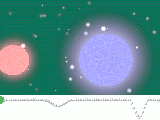John Michell

Cavendish-Experiment
John Michell (* 25. Dezember 1724; † 21. April 1793 in Thornhill, Yorkshire)[1] war ein englischer Naturphilosoph und Geologe.
Leben und Werk
Michell wurde 1762 Woodwardian Professor of Geology am Queens’ College der Universität Cambridge. 1760 wurde er zum Mitglied der Royal Society of London ernannt.
Michell konstruierte erstmals eine Torsionswaage zur Messung der Gravitationskraft, führte jedoch die entsprechenden Untersuchungen nicht durch. Sein Gerät wurde jedoch nach seinem Tode von Henry Cavendish 1797 erfolgreich zur Bestimmung der Gravitationskonstante verwendet. Cavendish weist in seinem Bericht an die Royal Society ausdrücklich auf die Verdienste Michells hin.
Michell gilt auch als Mitbegründer der Seismologie. 1760 führte er Erdbeben auf Wellenbewegungen in der Erde zurück. Er vermutete einen Zusammenhang zwischen Erdbeben und Vulkanismus.
Im August 1764 heiratete er in Fiskerton (Nottinghamshire) Sarah Williamson, mit der er eine Tochter (Dame Mary) hatte.[2]
Aufgrund der damals vorherrschenden Korpuskeltheorie des Lichts vermutete er 1783 den entsprechenden Einfluss der Gravitation auf das Licht und auch die Existenz von „Dunklen Sternen“, ähnlich den Schwarzen Löchern.

Ebenfalls 1783 wurde erstmals die Erklärung mit zwei unterschiedlichen Sternen für den bedeckungsveränderlichen Algol in einem Brief von Michell an Cavendish beschrieben.[3]
Michell konstruierte um 1780 ein Spiegelteleskop mit einem Metallspiegel von 75 Zentimeter Durchmesser – das seinerzeit weltgrößte Teleskop – und einer Brennweite von 3 Meter. Zeitgenössische Berichte sahen es als Erfolg: „performs extremly well on day-objects“,[4] rückblickend schätze es Henry C. King jedoch daran, auch unter Berücksichtigung des schwer zu meisternden hohen Öffnungsverhältnis, als wertlos für die Astronomie ein.[5] Das Spiegelteleskop mit zerbrochenem Spiegel wurde nach Michells Tod von William Herschel für wenig mehr als dem Materialpreis gekauft.[6][7]
Werke
- Observations on the Same Comet. In a Letter to Mr. James Short, F. R. S. In: Philosophical Transactions of the Royal Society. Vol. 51, 1759/1760, S. 466–467, doi:10.1098/rstl.1759.0044.
- A Recommendation of Hadley’s Quadrant for Surveying, Especially the Surveying of Harbours, Together with a Particular Application of It in Some Cases of Pilotage. In: Philosophical Transactions of the Royal Society. Vol. 55, 1765, S. 70–78, doi:10.1098/rstl.1765.0010.
- Proposal of a Method for Measuring Degrees of Longitude upon Parallels of the Æquator. In: Philosophical Transactions of the Royal Society. Vol. 56, 1766, S. 119–125, doi:10.1098/rstl.1766.0016.
- An Inquiry into the Probable Parallax, and Magnitude of the Fixed Stars, from the Quantity of Light Which They Afford us, and the Particular Circumstances of Their Situation. In: Philosophical Transactions of the Royal Society. Vol. 57, 1767, S. 234–264, doi:10.1098/rstl.1767.0028.
- On the Means of Discovering the Distance, Magnitude, &c. of the Fixed Stars, in Consequence of the Diminution of the Velocity of Their Light, in Case Such a Diminution Should be Found to Take Place in any of Them, and Such Other Data Should be Procured from Observations, as Would be Farther Necessary for That Purpose. In a Letter to Henry Cavendish, Esq. F. R. S. and A. S. In: Philosophical Transactions of the Royal Society. Vol. 74, 1784, S. 35–57, doi:10.1098/rstl.1784.0008.
Literatur
- Russell McCormmach: Weighing the World. The Reverend John Michell of Thornhill. Springer, Dordrecht / Heidelberg / London / New York NY 2012, ISBN 978-94-007-2021-3, e-ISBN 978-94-007-2022-0
- Michell, John. In: Encyclopædia Britannica. 11. Auflage. Band 18: Medal – Mumps. London 1911, S. 370 (englisch, Volltext [Wikisource]).
Weblinks
Einzelnachweise
- ↑ Michell, John (MCL742J). In: A Cambridge Alumni Database. University of Cambridge., abgerufen am 29. Dezember 2022 (englisch).
- ↑ FamilySearch.org. Abgerufen am 23. Juli 2024.
- ↑ Russell McCormmach: Weighing the World: The Reverend John Michell of Thornhill. Verlag Springer Science & Business Media, 2011, S. 360 Mitte
- ↑ The Scientific Papers of Sir William Herschel, Vol. I. London 1912, S. XXXII (archive.org).
- ↑ Henry C. King: The History of the Telescope. Courier Corporation, 1955, ISBN 978-0-486-43265-6, S. 91 (google.com).
- ↑ https://www.queens.cam.ac.uk/visiting-the-college/history/college-facts/john-michell
- ↑ E. Hutton: The Reverend John Michell: A Letter from his Great-grandson. In: Antiquarian Astronomer. Nr. 3, 2006, S. 65–68, bibcode:2006AntAs...3...65H.
| Personendaten | |
|---|---|
| NAME | Michell, John |
| KURZBESCHREIBUNG | englischer Naturphilosoph und Geologe |
| GEBURTSDATUM | 25. Dezember 1724 |
| STERBEDATUM | 21. April 1793 |
| STERBEORT | Thornhill, Yorkshire |
Auf dieser Seite verwendete Medien
Eclipsing binary star animation
Drawing of torsion balance apparatus used by Henry Cavendish in the 'Cavendish Experiment' to measure the gravitational constant in 1798. This is a vertical section through the apparatus, including the building that housed it. Copy of Figure 1 from his 1798 paper 'Experiments to determine the Density of the Earth' published in Philosophical Transactions of the Royal Society of London, (part II) 88 p.469-526 (21 June 1798). Alterations: removed frame and caption, compensated for shear distortion caused by scanning book, converted to PNG.

